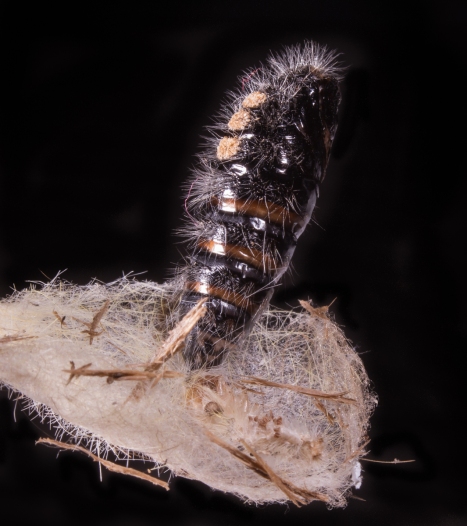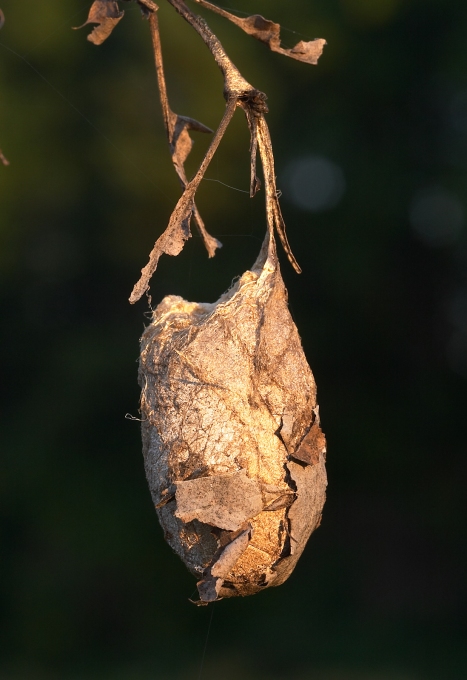Earlier this week I pulled a piece of wood out from under the deck and as I did, I apparently disturbed something that had been attached to the side of one of the boards. It was a cocoon of some sort, but it had a distinctive pupa that had been exposed by my actions.
Before continuing the story, a note on terminology may be in order – a pupa is the life stage between a larva (in the case of butterflies and moths, a caterpillar) and the adult. A butterfly pupa is usually called a chrysalis. A moth pupa is either a pupa or a cocoon. A cocoon is the silken case a moth caterpillar spins around it before it turns into a pupa.
Most of the moth caterpillars that bury into the ground to pupate produce an elongate brown pupal case that resembles a shiny sliver of wood in the smaller species or a cigar butt in some of the larger species.
Many of those that pupate above ground spin a silken “coat” around themselves before pupating. This undoubtedly offers some protection from the elements, parasites and predators. Inside a cocoon is usually a pupa that looks similar to the “naked” ones.
Now, back to the cocoon and pupa I had found. This pupa had abundant hairs and other raised projections coming off the pupal case. I had my suspicions who had made it but I went inside to search the web. There isn’t as much information out there on the pupae of moths as there is for adults and larvae. But, in some old references cited in a couple of web links, I found what I was looking for – this is the cocoon of a White-marked Tussock Moth, Orgyia leucostigma. And it is the pupa of a female moth – the pupa of a male apparently looks much more like a “normal” moth pupa without all the adornments.
This is a very common caterpillar in these parts and I have photographed them often as they are, well, just so interesting looking. “Tussock” means “tuft,” and the name refers to conspicuous tufts of hairs on the caterpillars. Many species in this family have long lashes, or tufts of so-called pencil hairs, scattered along the body, usually concentrated on the anterior and posterior ends.
This species (and a few others) also has a row of four brush-like tufts of white to tan hairs arising from the top of the caterpillar out of the first four abdominal segments. I have often referred to this larva as the toothbrush caterpillar because of these distinctive tufts. But, I don’t recommend it for dental hygiene as the setae can apparently cause skin irritations and a rash in sensitive individuals.
Many of the tussock caterpillars incorporate these hairs into their cocoon, which is probably for defensive purposes. Cocoons are attached to tree bark, logs, houses, and other objects in the environment. The female moths (which I have seen once) are wingless and lay their eggs in a frothy crust on the outside of their cocoon after emerging in the fall. The eggs are the life stage that overwinter.
As you would expect this time of year, for this species, the pupa was empty, so the female had apparently emerged. Since there were no eggs present, she must have either been parasitized (and the parasite emerged) or predated upon before she could mate and lay eggs. One thing that struck me as curious is that the pupa seems to have only three remnants of the four dorsal tufts present in the caterpillars. Wonder why? So many things to ponder, so little time…








